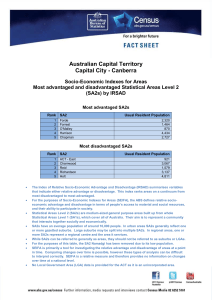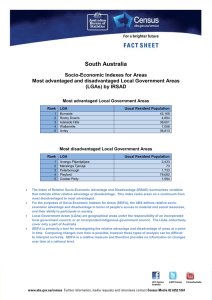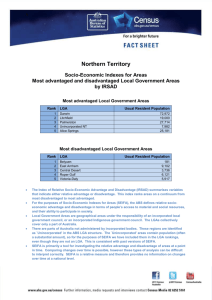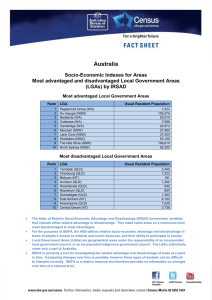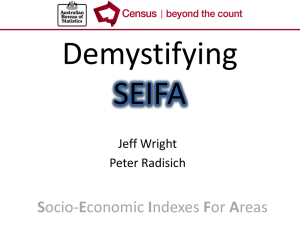Western Australia
advertisement
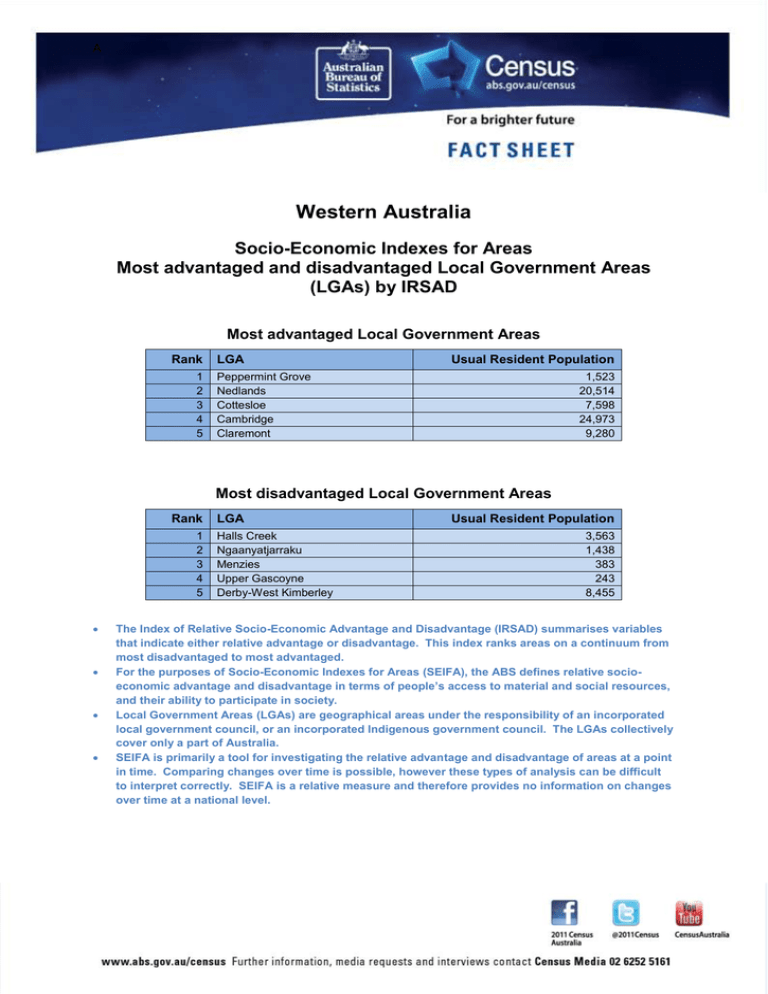
A Western Australia Socio-Economic Indexes for Areas Most advantaged and disadvantaged Local Government Areas (LGAs) by IRSAD Most advantaged Local Government Areas Rank 1 2 3 4 5 LGA Usual Resident Population Peppermint Grove Nedlands Cottesloe Cambridge Claremont 1,523 20,514 7,598 24,973 9,280 Most disadvantaged Local Government Areas Rank 1 2 3 4 5 LGA Halls Creek Ngaanyatjarraku Menzies Upper Gascoyne Derby-West Kimberley Usual Resident Population 3,563 1,438 383 243 8,455 The Index of Relative Socio-Economic Advantage and Disadvantage (IRSAD) summarises variables that indicate either relative advantage or disadvantage. This index ranks areas on a continuum from most disadvantaged to most advantaged. For the purposes of Socio-Economic Indexes for Areas (SEIFA), the ABS defines relative socioeconomic advantage and disadvantage in terms of people’s access to material and social resources, and their ability to participate in society. Local Government Areas (LGAs) are geographical areas under the responsibility of an incorporated local government council, or an incorporated Indigenous government council. The LGAs collectively cover only a part of Australia. SEIFA is primarily a tool for investigating the relative advantage and disadvantage of areas at a point in time. Comparing changes over time is possible, however these types of analysis can be difficult to interpret correctly. SEIFA is a relative measure and therefore provides no information on changes over time at a national level. A Western Australia Capital City - Perth Socio-Economic Indexes for Areas Most advantaged and disadvantaged Statistical Areas Level 2 (SA2s) by IRSAD Most advantaged SA2s Rank 1 2 3 4 5 SA2 Usual Resident Population North Coogee Iluka-Burns Beach City Beach Floreat Cottesloe 582 6,170 6,355 7,240 7,393 Most disadvantaged SA2s Rank 1 2 3 4 5 SA2 Mandurah Balga-Mirrabooka Armadale-Wungong-Brookdale Girrawheen Calista Usual Resident Population 8,566 18,035 16,259 8,341 7,380 The Index of Relative Socio-Economic Advantage and Disadvantage (IRSAD) summarises variables that indicate either relative advantage or disadvantage. This index ranks areas on a continuum from most disadvantaged to most advantaged. For the purposes of Socio-Economic Indexes for Areas (SEIFA), the ABS defines relative socioeconomic advantage and disadvantage in terms of people’s access to material and social resources, and their ability to participate in society. Statistical Areas Level 2 (SA2s) are medium-sized general purpose areas built up from whole Statistical Areas Level 1 (SA1s), which cover all of Australia. Their aim is to represent a community that interacts together socially and economically. SA2s have an average population of around 10,000 people. In urban areas SA2s generally reflect one or more gazetted suburbs. Large suburbs may be split into multiple SA2s. In regional areas, one or more SA2s represent a regional centre and the area it services. While SA2s can be referred to generally as areas, they should not be referred to as suburbs or LGAs. For the purposes of this table, the SA2 Kings Park has been removed due to its low population. SEIFA is primarily a tool for investigating the relative advantage and disadvantage of areas at a point in time. Comparing changes over time is possible, however these types of analysis can be difficult to interpret correctly. SEIFA is a relative measure and therefore provides no information on changes over time at a national level.
